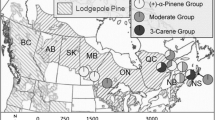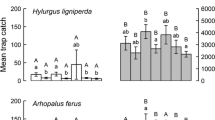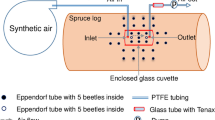Abstract
The effect of host tree species on the attractiveness of tunneling Ips pini to flying beetles and their insect predators in Wisconsin was investigated. Tree species influenced the flight response of both predators and prey in the same rank order. Ips pini and its major predators, Thanasimus dubius and Platysoma cylindrica, were more attracted to I. pini males boring into bark–phloem disks of Pinus strobus L. than Pinus banksiana Lamb, and least attracted to I. pini males boring into bark–phloem disks of Pinus resinosa. Sources of within-tree, between-tree, and between-species variation in the degree of attraction elicited by tunneling beetles were quantified. A bioassay for evaluating host tree effects on pheromone based communication among bark beetles under conditions of controlled beetle entry was developed. Possible mechanisms of host species effects on the dynamics of predator and prey interactions in bark beetle ecology are discussed.
Similar content being viewed by others
REFERENCES
ANDERSON, W. W., BERISFORD, C. W., TURNBOW, R. H., and BROWN, C. J. 1983. Genetic differencesamong populations of the black turpentine beetle, Dendroctonus terebrans and engraver beetle,Ips calligraphus (Coleoptera: Scolytidae). Ann. Entomol. Soc. Am. 76:896–902.
Billings, R, F., and Cameron, R, S. 1984, Kairomonal responses of Coleoptera: Monochamus titillator (Cerambycidae), Thanasimus dubius (Cleridae), and Temnochila virescens (Trogositidae), to behavioral chemicals of southern pine bark beetles (Dendroctonus frontalis) (Coleoptera: Scolytidae), Environ, Entomol, 13:1542–1548.
Billings, R, F., Gara, R, I., and Hrutfiord, B, F. 1976, Influence of ponderosa pine resin volatiles on the response of Dendroctonus ponderosae to synthetic trans-verbenol, Environ, Entomol, 5:171–179.
Birch, M, C. 1978, Chemical communication in pine bark beetles, Am, Sci. 66:409–419
Birch, M, C., Light, D, M., Wood, D, L., Browne, L, E., Silverstein, R, M., Bergot, B, J., Ohloff, G., West, J, R., and Young, J, C. 1980, Pheromonal attraction and allomonal interruption of Ips pini in California by the two enantiomers of ipsdienol, J, Chem, Ecol. 6:703–717.
Birgersson, G., Schlyter, F., LÖfqvist, J., and BergstrÖm, G. 1984, Quantitative variation of pheromone components in the spruce bark beetle Ips typographus from different attack phases, J, Chem, Ecol. 10:1029–1055.
Borden, J, H. 1982, Aggregation pheromones, pp, 74–139, in J, B, Mitton and K, B, Sturgeon (eds.), Bark Beetles in North American Conifers, University of Texas Press, Austin, Texas.
Borden, J, H. 1985, Aggregation pheromones, pp, 257–285, in G, A, Kerkurt and L, I, Gilbert (eds.), Comprehensive Insect Physiology, Biochemistry and Pharmacology, Pergamon Press, Oxford.
Borden, J, H. 1989, Semiochemicals and bark beetle populations: Exploitation of natural phenomena by pest management strategies, Holarct, Ecol. 12:501–510.
Borden, J, H., Conn, J, E., Friskie, L, M., Scott, B, E., and Chong, L, J. 1982, Semiochemicals for the mountain pine beetle, Dendroctonus ponderosae (Coleoptera: Scolytidae), in British Columbia: Baited-tree studies, Can, J, For, Res. 13:325–333.
Borden, J, H., Hunt, D, W, A., Miller, D, R., and Slessor, K, N. 1986, Orientation in forest Coleoptera: An uncertain outcome of responses by individual beetles to variable stimuli, pp, 97–109, in T, L, Payne, M, L, Birch, and C, E, J, Kennedy (eds.), Mechanisms in Insect Olfaction, Oxford University Press, New York.
Borden, J, H., Wilson, I, M., Gries, R., Chong, L, J., Pierce, H, D., and Gries, G. 1998, Volatiles from the bark of trembling aspen, Populus tremuloides Michx, (Salicacaeae), disrupt secondary attraction by mountain pine beetle, Dendroctonus ponderosae Hopkins (Coleoptera: Scolytidae), Chemoecology 8:69–75.
Bridgen, M, R., Hanover, J, W., and Wilkinson, R, C. 1979, Oleoresin characteristics of eastern white pine seed sources and relationship to weevil resistance, For, Sci. 25:175–183.
Byers, J, A. 1983, Bark beetle conversion of a plant compound to a sex-specific inhibitor of pheromone attraction, Science 220:624–626.
Byers, J, A., and Birgersson, G, 1990, Pheromone production in a bark beetle independent of myrcene precursor in host pine species, Naturwissenschaften 77:385–387.
Conn, J, E., Borden, J, H., Scott, B, E., Friske, L, M., Pierce, H, D., JR., and Oehlschlager, A, C. 1983, Semiochemicals for the mountain pine beetle, Dendroctonus ponderosae (Coleoptera: Scolytidae) in British Columbia: Field trapping studies, Can, J, For, Res. 13:320–324.
Deglow, E, K., and Borden, J, H, 1998, Green leaf volatiles disrupt and enhance response to aggregation pheromones by the ambrosia beetle, Gnathotrichus sulcatus (Coleoptera: Scolytidae), Can, J, For, Res. 28:1697–1705.
Dickens, J, C., Billings, R, F., and Payne, T, L. 1992, Green leaf volatiles interrupt aggregation pheromone response in bark beetles infesting southern pines, Experientia 48:523–524.
Fish, R, H., Browne, L, E., and Bergot, B, J. 1984, Pheromone biosynthetic pathways: Conversion of ipsdienone to ( — )-ipsdienol, a mechanism for enantioselective reduction in the male bark beetle, Ips paraconfusus. J, Chem, Ecol. 10:1057–1064
Fowler, D, P., and Lester, D, T. 1970, The genetics of red pine, USDA For, Serv, Res. Pap, WO-8, USDA, Washington, D.C.
Geiszler, D, R., and Gara, R, I. 1978, Mountain pine beetle attack dynamics in lodgepole pine, pp, 182–187, in A, A, Berryman, G, D, Amman, R, W, Stark, and D, L, Kibbee (eds.), Theory and Practice of Mountain Pine Beetle Management in Lodgepole Pine Forests, College of Forest Resources, University of Idaho, Moscow, Idaho.
GrÉgoire, J, C., Coullien, D., Drumont, A., Meyer, H., and Francke, W. 1992, Semiochemicals and the management of Rhizophagus grandis Gyll (Coleoptera: Rhizophagidae) for the biocontrol of Dendroctonus micans Kug (Coleoptera: Scolytidae), Angew, Entomol, 114:110–112.
Groberman, L, J., and Borden, J, H. 1981, Behavioral response of Dendroctonus pseudotsugae and Trypodendron lineatum (Coleoptera: Scolytidae) to selected wavelength regions of the visible spectrum, Can, J, Zool, 59:2159–2165.
Hendry, L, B., Piatek, B., Browne, L, E., Wood, D, L., Byers, J, A., Fish, R, H., and Hicks, R, A. 1980, In vivo conversion of a labeled host plant chemical to pheromones of the bark beetle Ips paraconfusus, Nature 248:485.
Hobson, K, R., Wood, D, L., Cool, L, G., White, P, R., Ohtsuka, T., Kubo, I., and Zavarin, E. 1993, Chiral specificity in responses by the bark beetle Dendroctonus valens to host kairomones, J, Chem, Ecol. 19:1837–1847.
Hughes, P, R. 1973, Dendroctonus: Production of pheromones and related compounds in response to host monoterpenes, Z, Angew, Entomol, 73:294–312.
Ivarsson, P., Blomquist, G, T., and Seybold, S, J. 1997, In vitro production of the pheromone, Intermediates ipsdienone and ipsenone localized in the metathorax of Ips paraconfusus Lanier (Coleoptera: Scolytidae), Naturwissenschaften 84:454–457.
Kirkendall, L, R. 1983, The evolution of mating systems in bark and ambrosia beetles (Coleoptera: Scolytidae and Platypodidae), Zool, J, Linn, Soc. 77:293–352.
Klepzig, K, D., Raffa, K, F., and Smalley, E, B. 1991, Association of insect-fungal complexes with red pine decline in Wisconsin, For, Sci. 37:1119–1139.
Klepzig, K, D., Kruger, E, L., Smalley, E, B., and Raffa, K, F. 1995, Effects of biotic and abiotic stress on the induced accumulation of terpenes and phenolics in red pines inoculated with a bark beetle vectored fungus, J, Chem, Ecol, 21:601–626.
Klepzig, K, D., Smalley, E, B., and Raffa, K, F. 1996, Combined chemical defenses against insects and fungi associated with a forest decline disease, J, Chem, Ecol, 22:1376–1388.
Lanier, G, N. 1972, Biosystematics of the genus Ips (Coleoptera: Scolytidae) in North America, Hopping's Group IV and X, Can, Entomol, 104:361–388.
Lanier, G, N., Birch, M, C., Schmitz, R, F., and Furniss, M, M. 1972, Pheromones of Ips pini (Coleoptera: Scolytidae): Variation in response among three populations, Can, Entomol, 104:1917–1923.
Lanier, G, N., Claesson, A., Stewart, T., Piston, J., and Silverstein, R, M. 1980, Ips pini: The basis for interpopulational differences in pheromone biology, J, Chem, Ecol, 6:677–687.
Lindgren, B, S. 1983, A multiple-funnel trap for scolytid beetles (Coleoptera), Can, Entomol, 115:299–302.
MacÍas-SÁmano, J, E., Borden, J, H., Gries, R., Pierce, H, D., JR., Gries, G., and King, G, G, S. 1998, Primary attraction of the fir engraver beetle, Scolytus ventralis, J, Chem, Ecol, 24:1049–1075.
Miller, D, R. 1990, Reproductive and ecological isolation: Community structure in the use of semiochemicals by pine bark beetles (Coleoptera: Scolytidae), PhD thesis, Simon Fraser University, Burnaby, British Columbia.
Miller, D, R., and Borden, J, H. 1990, b-Phellandrene: Kairomone for pine engraver, Ips pini (Say) (Coleoptera: Scolytidae), J, Chem, Ecol, 16:2519–2531.
Miller, D, R., Borden, J, H., and Slessor, K, N. 1989, Inter-and intrapopulation variation of the pheromone, ipsdienol produced by male pine engravers, Ips pini (Say) (Coleoptera: Scolytidae), J, Chem, Ecol, 15:233–247.
Miller, D, R., Gries, G., and Borden, J, H. 1990, (E)-Myrcenol: A new pheromone for the pine engraver, Ips pini (Coleoptera: Scolytidae), Can, Entomol, 122:401–406.
Miller, D, R., Gibson, K, E., Raffa, K, F., Seybold, S, J., Teale, S, A., and Wood, D, L. 1997, Geographic variation in response of pine engraver, Ips pini, and associated species to pheromone, lanierone, J, Chem, Ecol, 23:2013–2031.
Mirov, N, T. 1961, Composition of gum turpentines of pines, USDA For, Serv, Tech, Bull. 1239, USDA, Washington, D.C.
Mizell, R, F.,JR., III, Frazier, J, L., and Nebeker, T, E. 1984, Response of the clerid predator Thanasimus dubius (F.) to bark beetle pheromones and tree volatiles in a wind tunnel, J, Chem, Ecol, 10:177–187.
Moeck, H, A., Wood, D, L., and Lindahl, K, Q., JR. 1981, Host selection behavior of bark beetles (Coleoptera: Scolytidae) attacking Pinus ponderosa, with special emphasis on the western pine beetle, Dendroctonus brevicomis, J, Chem, Ecol, 7:49–83.
Neter, J., Wasserman, W., and Kutner, M, H. 1983, Applied Linear Regression Models, Richard D, Irwin, Homewood, Illinois.
Pierce, H, D., JR., Conn, J, E., Oehlschlager, A, C., and Borden, J, H. 1987, Monoterpene metabolism in female mountain pine beetles, Dendroctonus ponderosae Hopkins attacking ponderosa pine, J, Chem, Ecol, 13:1455–1480.
Piston, J, J., and Lanier, G, N. 1974, Pheromones of Ips pini (Coleoptera: Scolytidae), Response to interpopulational hybrids and relative attractiveness of males boring in two host species, Can, Entomol, 106:247–251.
Pitman, G, B., and VitÉ J, P. 1970, Field responses of Dendroctonus pseudotsugae (Coleoptera: Scolytidae) to synthetic frontalin, Ann, Entomol, Soc, Am. 63:661–664
Raffa, K, F. 1991, Temporal and spatial disparities among bark beetles, predators, and associates responding to synthetic bark beetle pheromones: Ips pini (Coleoptera: Scolytidae) in Wisconsin, Environ, Entomol, 20:1665–1679.
Raffa, K, F. 1995, Differential responses among natural enemies and prey to bark beetle pheromones: Implications of chemical, temporal, and spatial disparities to evolutionary theory and pest management, pp, 208–225, in F, Hain, S, M, Salom, W, F, Ravlin, T, Payne, and K, F, Raffa (eds.), Behavior, Population Dynamics and Control of Forest Insects, Proceedings, International Union of Forestry Research Organizations.
Raffa, K, F., and Berryman, A, A. 1982, Physiological differences between lodgepole pines resistant and susceptible to the mountain pine beetle and associated microorganisms, Environ, Entomol, 11:486–492.
Raffa, K, F., and Berryman, A, A. 1983, Physiological aspects of lodgepole pine wound responses to a fungal symbiont of the mountain pine beetle, Dendroctonus ponderosae (Coleoptera: Scolytidae), Can, Entomol, 115:723–734.
Raffa, K, F., and Dahlsten, D, L. 1995, Differential response among natural enemies and prey to bark beetle pheromones, Oecologia 102:17–23.
Raffa, K, F., and Klepzig, K, D, 1989, Chiral escape of bark beetles from predators responding to a bark beetle pheromone, Oecologia 80:566–569.
Raffa, K, F., and Smalley, E, B. 1995, Interactions of pre-attack and induced monoterpene concentrations in host conifer defense against bark beetle-microbial complexes, Oecologia 102:285–295.
Raffa, K, F., Phillips, T, W., and Salom, S, M. 1993, Strategies and mechanisms of host colonization by bark beetles, pp, 103–128, in T, O, Schowalter, and G, Filip (eds.), Interactions Among Bark Beetles Pathogens and Conifers in North American Forests, Academic Press, New York.
Renwick, J, A, A., and Vit É, J, P. 1972, Pheromones and host volatiles that govern aggregation of the six-spined engraver beetle, Ips calligraphus, J, Insect, Physiol, 18:1215–1219.
Renwick, J, A, A., Hughes, P, R., and Krull, I, S. 1976, Selective production of cis-and transverbenol from (-)-and (+)-a-pinene by a bark beetle, Science 191:199–201.
Rudolph, T, D., and Yeatman, C, W. 1978, Genetics of jack pine, USDA For, Serv, Res, Paper WO-32, USDA, Washington, D.C.
SAS Institute, 1996, Littell, R, C., Milliken, G, A., Stroup, W, W., and Wolfinger, R, D., SAS System for Mixed Models, SAS Institute Inc., Cary, North Carolina.
Schenk, J, A, L., and Benjamin, D, M. 1969, Notes on the biology of Ips pini in central Wisconsin jack pine forests, Pinus banksiana, Ann, Entomol, Soc, Am. 62:480-485.
Seybert, J, P., and Gara, R, I. 1970, Notes on flight and host-selection behavior of the pine engraver, Ips pini (Coleoptera: Scolytidae), Ann, Entomol, Soc, Am. 63:947-950.
Seybold, S, J. 1992, The role of chirality in the olfactory directed aggregation behavior of pine engraver beetles in the genus Ips (Coleoptera: Scolytidae), PhD thesis, University of California, Berkeley.
SEYBOLD, S, J, 1993, Role of chirality in olfactory-directed behavior: Aggregation of pine engraver beetles in the genus Ips (Coleoptera: Scolytidae), J, Chem, Ecol. 19:1809-1831.
Seybold, S, J., Teale, S, A., Wood, D, L., Zhang, A., Webster, F, X., Lindahl, K, Q., JR., and Kubo, I. 1992, The role of lanierone in the chemical ecology of Ips pini (Coleoptera: Scolytidae) in California, J, Chem, Ecol. 18:2305-2329.
Seybold, S, J., Quilici, D, R., Tillman, J, A., Vanderwel, D., Wood, D, L., and Blomquist, G, J. 1995a, De novo bosynthesis of the aggregation pheromone components ipsenol and ipsdienol by the pine engraver beetles Ips paraconfusus Lanier and Ips pini (Say) (Coleoptera: Scolytidae), Proc, Natl, Acad, Sci, U.S.A. 92:8393-8397.
Seybold, S, J., Ohtsuka, T., Wood, D, L., and Kubo, I. 1995b, The enantiomeric composition of ipsdienol: A chemotaxonomic character for North American populations of Ips spp, in the pini subgeneric group (Coleoptera: Scolytidae), J, Chem, Ecol. 21:995-1016.
Shepherd, R, F. 1966, Factors influencing the orientation and rates of activity of Dendroctonus ponderosae Hopkins (Coleoptera: Scolytidae), Can, Entomol, 98:507-518.
Smith, R, H., Peloquin, R, L., JR., and Passof, P, A. 1969, Local and regional variation in the monoterpenes of ponderosa pine xylem resin, USDA For, Serv, Res, Pap. PSW-56, USDA, Washington, D.C.
Stephen, F, M., and Dahlsten, D, L. 1976, The arrival sequence of the arthropod complex following attack by Dendroctonus brevicomis (Coleoptera: Scolytidae) in ponderosa pine, Can, Entomol, 108:283-304.
Stock, M, W., and Amman, G, D. 1980, Genetic differentiation among mountain pine beetle populations from lodgepole pine and ponderosa pine in northeast Utah, Ann, Entomol, Soc, Am. 73:472-478.
Strom, B, L., Roton, L, M., and Ingram, L, L., JR. 1994, Repellent properties of the host compound 4-allylanisole to the southern pine beetle, J, Chem, Ecol. 20:1579-1615
Sturgeon, K, B. 1979, Monoterpene variation in ponderosa pine xylem resin related to western pine beetle predation, Evolution 33:803-814.
Teale, S, A., Webster, F, X., Zhang, A., and Lanier, G, N. 1991, Lanierone: A new pheromone component from Ips pini (Coleoptera: Scolytidae) in New York, J, Chem, Ecol. 17:1159-1176.
TØmmeras, B, Å. 1989, Host selection by odors compounds from host and nonhost trees in bark beetles, Fauna Norv, Serv, B 36:75-79.
TØmmeras, B, Å., and Mustaparta, H. 1987, Chemoreception of host volatiles in the bark beetle Ips typographus, J, Comp, Physiol, A, Sens, Neurol, Behav, Physiol, 161:705-710.
Vanderwel, D, 1994, Factors affecting pheromone production in beetles, Arch, Insect Biochem, Physiol, 25:347-362.
Vanderwel, D., and Oehlschlager, C, A. 1987, Biosynthesis of pheromones and endocrine regulation of pheromone production in Coleoptera, pp, 175-215, in G, D, Prestwich, and G, J. Blomquist (eds.), Pheromone Biochemistry. Academic Press, Orlando, Florida
VitÉ, J, P., and Renwick, J, A, A. 1968, Insect and host factors in the aggregation of the southern pine beetle, Contrib, Boyce Thompson Inst, 24:61-63
VitÉ, J, P., and Renwick, J, A, A. 1971, Population aggregating pheromone in the bark beetle, Ips grandicollis. J, Insect Physiol, 17:1699-1704
VitÉ, J, P., Bakke, A., and Renwick, J, A, A. 1972, Pheromones in Ips (Coleoptera: Scolytidae): Occurrence and production, Can, Entomol, 104:1967-1975.
Wallin, K, F., and Raffa, K, F. 1999, Altered constitutive and inducible phloem monoterpenes following natural defoliation of jack pine: Implications to host mediated inter-guild interactions and plant defense theories, J, Chem, Ecol. 25: In press.
Wood, D, L. 1962, Experiments on the interrelationship between oleoresin exudation pressure in Pinus ponderosa and attack by Ips confusus (Lec.) (Coleoptera: Scolytidae), Can, Entomol, 94:473-477.
Wood, D, L. 1982, The role of pheromones, kairomones, and allomones in the host selection and colonization behavior of bark beetles, Annu, Rev, Entomol, 27:411-446.
Wood, D, L., Browne, L, E., Bedard, W, D., Tilden, P, E., Silverstein, R, M., and Rodin, J, O. 1968, Response of Ips confusus to synthetic sex pheromones in nature, Science 159:1373-1374.
Wood, S, L, 1982, The bark and ambrosia beetles of North and Central America (Coleoptera: Scolytidae): A taxonomic monograph, Great Basin Naturalist Memoirs, No, 6, Brigham Young University, Provo, Utah.
Wright, J, W. 1970, Genetics of eastern white pine, USDA For, Serv, Res, Paper WO-9, USDA, Washington, D.C.
Zar, J, H. 1996, Biostatistical analysis, Third edition, Prentice Hall, Upper Saddle River, New Jersey, 622 pp.
Author information
Authors and Affiliations
Rights and permissions
About this article
Cite this article
Erbilgin, N., Raffa, K.F. Effects of Host Tree Species on Attractiveness of Tunneling Pine Engravers, Ips pini, to Conspecifics and Insect Predators. J Chem Ecol 26, 823–840 (2000). https://doi.org/10.1023/A:1005495806100
Issue Date:
DOI: https://doi.org/10.1023/A:1005495806100




